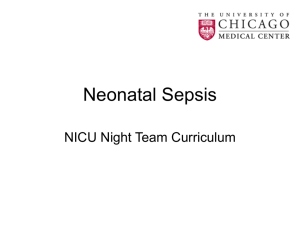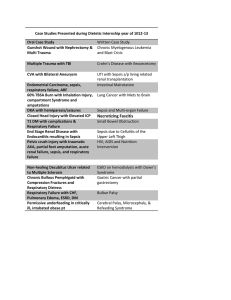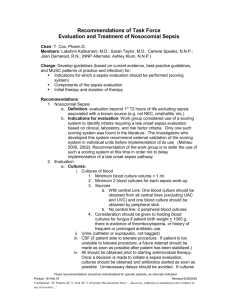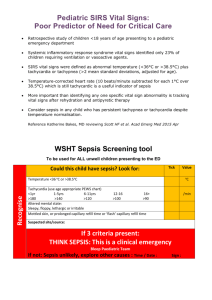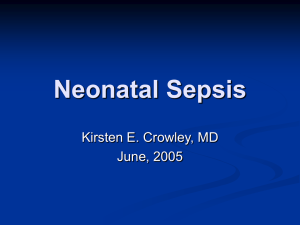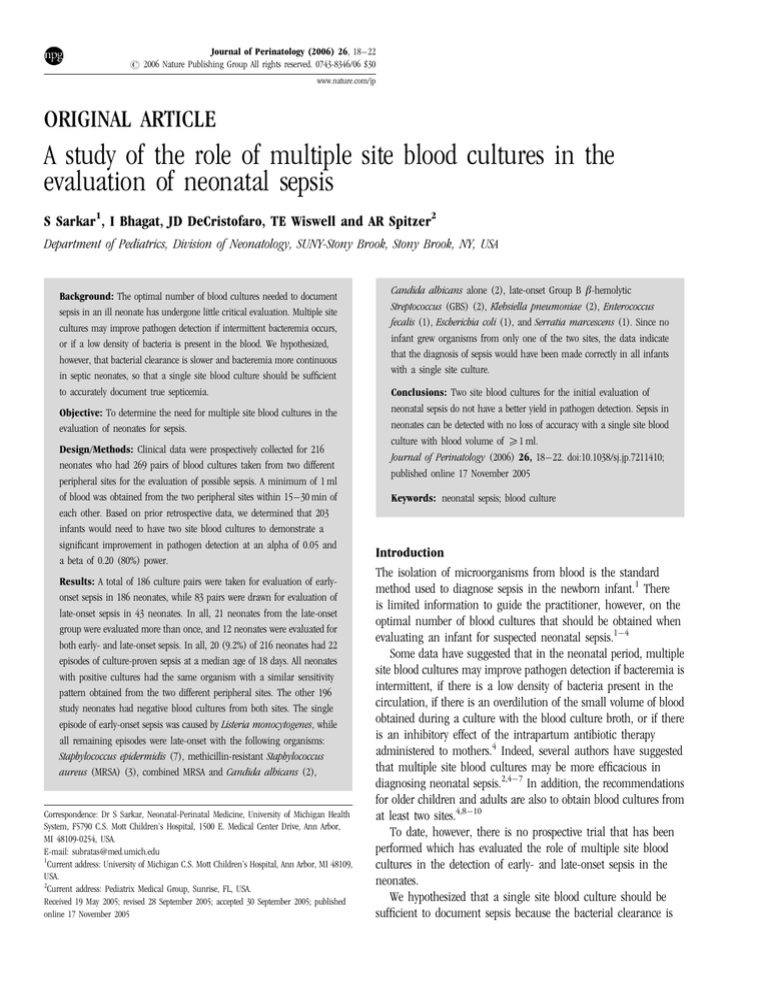
Journal of Perinatology (2006) 26, 18–22
r 2006 Nature Publishing Group All rights reserved. 0743-8346/06 $30
www.nature.com/jp
ORIGINAL ARTICLE
A study of the role of multiple site blood cultures in the
evaluation of neonatal sepsis
S Sarkar1, I Bhagat, JD DeCristofaro, TE Wiswell and AR Spitzer2
Department of Pediatrics, Division of Neonatology, SUNY-Stony Brook, Stony Brook, NY, USA
Background: The optimal number of blood cultures needed to document
sepsis in an ill neonate has undergone little critical evaluation. Multiple site
cultures may improve pathogen detection if intermittent bacteremia occurs,
or if a low density of bacteria is present in the blood. We hypothesized,
however, that bacterial clearance is slower and bacteremia more continuous
in septic neonates, so that a single site blood culture should be sufficient
to accurately document true septicemia.
Objective: To determine the need for multiple site blood cultures in the
evaluation of neonates for sepsis.
Design/Methods: Clinical data were prospectively collected for 216
neonates who had 269 pairs of blood cultures taken from two different
peripheral sites for the evaluation of possible sepsis. A minimum of 1 ml
of blood was obtained from the two peripheral sites within 15–30 min of
each other. Based on prior retrospective data, we determined that 203
infants would need to have two site blood cultures to demonstrate a
significant improvement in pathogen detection at an alpha of 0.05 and
a beta of 0.20 (80%) power.
Results: A total of 186 culture pairs were taken for evaluation of earlyonset sepsis in 186 neonates, while 83 pairs were drawn for evaluation of
late-onset sepsis in 43 neonates. In all, 21 neonates from the late-onset
group were evaluated more than once, and 12 neonates were evaluated for
both early- and late-onset sepsis. In all, 20 (9.2%) of 216 neonates had 22
episodes of culture-proven sepsis at a median age of 18 days. All neonates
with positive cultures had the same organism with a similar sensitivity
pattern obtained from the two different peripheral sites. The other 196
study neonates had negative blood cultures from both sites. The single
episode of early-onset sepsis was caused by Listeria monocytogenes, while
all remaining episodes were late-onset with the following organisms:
Staphylococcus epidermidis (7), methicillin-resistant Staphylococcus
aureus (MRSA) (3), combined MRSA and Candida albicans (2),
Correspondence: Dr S Sarkar, Neonatal-Perinatal Medicine, University of Michigan Health
System, F5790 C.S. Mott Children’s Hospital, 1500 E. Medical Center Drive, Ann Arbor,
MI 48109-0254, USA.
E-mail: subratas@med.umich.edu
1
Current address: University of Michigan C.S. Mott Children’s Hospital, Ann Arbor, MI 48109,
USA.
2
Current address: Pediatrix Medical Group, Sunrise, FL, USA.
Received 19 May 2005; revised 28 September 2005; accepted 30 September 2005; published
online 17 November 2005
Candida albicans alone (2), late-onset Group B b-hemolytic
Streptococcus (GBS) (2), Klebsiella pneumoniae (2), Enterococcus
fecalis (1), Escherichia coli (1), and Serratia marcescens (1). Since no
infant grew organisms from only one of the two sites, the data indicate
that the diagnosis of sepsis would have been made correctly in all infants
with a single site culture.
Conclusions: Two site blood cultures for the initial evaluation of
neonatal sepsis do not have a better yield in pathogen detection. Sepsis in
neonates can be detected with no loss of accuracy with a single site blood
culture with blood volume of X1 ml.
Journal of Perinatology (2006) 26, 18–22. doi:10.1038/sj.jp.7211410;
published online 17 November 2005
Keywords: neonatal sepsis; blood culture
Introduction
The isolation of microorganisms from blood is the standard
method used to diagnose sepsis in the newborn infant.1 There
is limited information to guide the practitioner, however, on the
optimal number of blood cultures that should be obtained when
evaluating an infant for suspected neonatal sepsis.1–4
Some data have suggested that in the neonatal period, multiple
site blood cultures may improve pathogen detection if bacteremia is
intermittent, if there is a low density of bacteria present in the
circulation, if there is an overdilution of the small volume of blood
obtained during a culture with the blood culture broth, or if there
is an inhibitory effect of the intrapartum antibiotic therapy
administered to mothers.4 Indeed, several authors have suggested
that multiple site blood cultures may be more efficacious in
diagnosing neonatal sepsis.2,4–7 In addition, the recommendations
for older children and adults are also to obtain blood cultures from
at least two sites.4,8–10
To date, however, there is no prospective trial that has been
performed which has evaluated the role of multiple site blood
cultures in the detection of early- and late-onset sepsis in the
neonates.
We hypothesized that a single site blood culture should be
sufficient to document sepsis because the bacterial clearance is
Role of multiple site blood cultures
S Sarkar et al
19
Methods
Clinical data were prospectively collected on 216 neonates who had
blood cultures taken from two different peripheral sites for the
evaluation of possible early- or late-onset sepsis in the neonatal
intensive care unit at the State University of New York at Stony
Brook. The study was initiated as a QA process, and during the
study period, between December 2001 and November 2002, the
standard of care in the Neonatal Intensive Care Unit had been to
obtain blood samples for culture from two different peripheral sites
in neonates. Use of the QA data for research purposes was
subsequently approved by the Committee on Research Involving
Human Subjects of the State University of New York at Stony Brook.
Blood cultures were obtained from two different peripheral sites
within 15–30 min of each other in each study neonate. A
minimum of 1 ml of blood was obtained from each site for
inoculation in the BD Bactec Pediatrics Plus/F aerobic bottle
(Becton Dickinson Co., Sparks, MD 21152) after skin cleansing
using the standard policy of the unit, comprising three consecutive
at least 10 s cleanings with premoistened 10% povidone iodine swab
with at least 30 s drying time before blood sampling. The use of two
or more consecutive cleanings, and/or a longer duration of
cleansing has been recommended for more effective skin
sterilization in previous studies.12 No central line blood samples
were drawn for the study purposes.
The procedure guidelines for blood cultures were developed and
the medical and nursing staff was observed to ensure proper
technique during the study.
Statistical analysis
In a prior retrospective study from our group,4 18 of 460 infants
(3.9%) from whom multiple site blood cultures were obtained, the
second set of cultures helped to either confirm bacteremia (n ¼ 8,
1.7%) or to confirm contamination (n ¼ 10, 2.2%). Assuming
3.9% of multiple site blood cultures would add information
additional to a single culture (0%), we estimated that 203 infants
would require two site blood cultures to demonstrate a similar
improvement in pathogen detection, at an alpha of 0.05 and a beta
of 0.20 (80%) power.
Data were analyzed using a multivariate analysis using a
logistic regression model to assess if specific neonatal
characteristics and factors could predict positive result of blood
cultures from both sites in neonates with suspected late-onset
sepsis.
Results
During the study period, 216 consecutive infants with suspected
early- and late-onset sepsis were studied. In all, 173 neonates were
evaluated for possible early-onset sepsis alone, 30 neonates were
studied only for possible late-onset sepsis, while 13 neonates were
evaluated for both early- and late-onset sepsis. A total of 186
neonates in the early-onset group and 43 neonates in the late-onset
group comprised the final totals. In all, 21 of the 43 neonates from
the late-onset group were evaluated more than once for suspected
late-onset sepsis.
A total of 269 pairs of blood cultures were drawn from two sites
for evaluation of possible sepsis in the 216 neonates. In all, 186
culture pairs were obtained for evaluation of possible early-onset
sepsis in 186 neonates, while 83 culture pairs were drawn during
83 episodes of suspected late-onset (>7 days of life) sepsis in 43
neonates.
Mean gestational age and mean birth weight for 186 neonates
evaluated for early-onset sepsis were 34.8 weeks ±s.d. 4.5 and
2507.9 g ±s.d. 988.6 respectively; and gestation at delivery and
birth weight in 43 neonates evaluated for late-onset sepsis were
28.7 weeks ±s.d. 4 and 1272.6 g ±s.d. 711, respectively. Figure 1
shows the distribution of gestational ages at birth in neonates who
were evaluated for sepsis. The greatest number of infants from the
early-onset group were born beyond 37 weeks of gestation, while
the majority of the infants from late-onset group were born prior to
28 weeks of gestation and remained in the neonatal intensive care
unit for a sufficient period of time to develop multiple episodes of
suspected late-onset sepsis.
The maternal risk factors which prompted evaluation for earlyonset sepsis in 186 infants were clinical chorioamnionitis in 127
infants (68%), preterm labor and premature rupture of membranes
(PROM) for longer than 24 h in 54 infants (29%), and a positive
GBS screening culture obtained during pregnancy, with inadequate
intrapartum antibiotic prophylaxis in 29 cases (16%). Subsequent
histopathological examination of the placenta was consistent with
chorioamnionitis in 59 of the 127 (46.5%) women with clinical
chorioamnionitis. All 127 women with clinical chorioamnionitis
were treated with intrapartum antibiotics.
70%
60%
Percentage of Infants
slower and the bacteremia more continuous in neonates with
sepsis than in older patients.11 We therefore conducted this
prospective, observational study to determine the usefulness
of two site blood cultures in the initial evaluation of neonates
for sepsis.
50%
40%
Early onset sepsis
Late onset sepsis
30%
20%
10%
0%
29-32
33-36
≤ 28
≥37
Gestational Age (Weeks) at Birth
Figure 1 Distribution of gestational ages in neonates evaluated for
early-onset (N ¼ 186), and late-onset sepsis (N ¼ 43).
Journal of Perinatology
Role of multiple site blood cultures
S Sarkar et al
20
In all, 126 of the infants (68%) from early-onset group were
symptomatic soon after birth and 112 (89%) of those neonates had
respiratory distress at the time of initial clinical examination. The
causes of respiratory distress were subsequently noted to be due to
transient tachypnea of the neonate (TTN) in 65 infants, RDS in 35
infants and other diagnoses (e.g., MAS, PPHN, pneumonia) were
made in 12 infants. In all, 55 of the 112 (49%) infants with
respiratory distress were being treated with nasal continuous
positive airway pressure (NCPAP) or mechanical ventilation at the
time of evaluation for early-onset sepsis. In all, 14 infants (8%)
were febrile soon after birth. The secondary diagnosis in all 186
neonates from the early-onset group, whether symptomatic or
asymptomatic, was suspected neonatal septicemia because of
presence of maternal predisposing factors for sepsis.
In the late onset group, the indications for performing blood
cultures during 83 episodes of possible sepsis in 43 infants were as
follows: a septic appearance as evidenced by presence of lethargy,
hypotonia and mottled appearance during 35 of 83 episodes (42%),
hyperglycemia and temperature instability during 17 episodes
(20.5%), feeding difficulties with suspected necrotizing enterocolitis
in 14 instances (17%), recurring severe apnea and bradycardia
during five episodes (6%), an abscess at the site of an intravenous
catheter insertion or skin incision site for PDA ligation during two
(2.4%) episodes, and combination of abovementioned symptoms
during 10 other episodes.
Neonates who were evaluated for late onset sepsis were receiving
treatment with CPAP or mechanical ventilation during 70 of the 83
episodes of possible sepsis. The indications for CPAP or mechanical
ventilation were resolving RDS during 38 episodes, evolving BPD
during 28 episodes, resolving MAS pneumonia, and recurrent
apnea in two instances each. During 33 (41%) of those 70 possible
sepsis episodes, infants had an increase in ventilatory requirement
with onset of sepsis. Neonates from the late onset group had central
venous catheters (peripherally inserted central catheter (PICC),
umbilical venous catheter, or Broviac catheter) in place during 32
episodes and were receiving total parenteral nutrition and intralipid
during 72 episodes of possible sepsis. Neonates with possible lateonset sepsis, compared with neonates with early-onset sepsis, had a
significantly higher white blood cell count (mean 20 300/
mm3 ±s.d. 9500 vs mean 14 700/mm3 ±s.d. 7900) and higher
immature: total neutrophil ratio (mean 0.28±s.d. 0.2 vs mean
0.14±s.d. 0.1).
Blood culture results revealed that 20 (9.2%) of 216 neonates
had 22 episodes of culture proven sepsis at a median age of 18
days. Only one of the 20 neonates with a positive blood culture had
an episode of early-onset sepsis. This infant’s septicemia was
caused by Listeria monocytogenes while all other remaining 21
episodes of blood culture proven sepsis were late onset.
The organisms grown in addition to L. monocytogenes during
remaining episodes were: coagulase negative Staphylococci in
seven; methicillin-resistant Staphylococcus aureus (MRSA), late
Journal of Perinatology
Table 1 Pathogens isolated from blood cultures during 22 episodes of
Sepsis in 20 neonates
Pathogens
Coagulase Negative Staph
MRSA
MRSA and Candida
Candida
Group B Strep (late onset)
Klebsiella pneumoniae
Escherichia coli
Enterococcus fecalis
Listeria monocytogenes
Serratia marcescens
Number of episodes
7
3
2
2
2
2
1
1
1
1
onset Group B Streptococcus, Gram-negative organisms and
Candida in others (Table 1).
All 20 neonates with positive blood cultures had the same
organisms with similar sensitivity patterns obtained from the two
different peripheral sites during 22 episodes of sepsis. The
remaining 196 of 216 study neonates had negative blood cultures
from both sites.
We performed a multivariate analysis using a logistic regression
model to assess if specific neonatal characteristics and factors can
predict positive result of blood cultures from both sites in neonates
with suspected late-onset sepsis. The factors which showed a
positive correlation on univariate analysis were I:T neutrophil ratio
X0.2 (P ¼ 0.011), presence of thrombocytopenia (P ¼ 0.006),
fever (P ¼ 0.004), presence of central line (P ¼ 0.012), TPN/Lipid
infusion (P ¼ 0.015), hypo or hyperglycemia (P ¼ 0.004),
increase in ventilatory requirements (P ¼ 0.005), and septic
appearance (P ¼ 0.00) but on multivariate analysis, the septic
appearance (OR 35.53, P ¼ 0.000) and thrombocytopenia (OR
8.97, P ¼ 0.007) were the only significant predictors for positive
blood culture in infants with suspected late-onset sepsis.
Discussion
The isolation of microorganisms from blood remains the most
valid method of diagnosing bacterial sepsis in the newborn.1,4 But
the number of blood cultures required to document sepsis in an ill
neonate, however, has had minimal evaluation to date.3 Studies
comparing two blood cultures vs a single site blood culture in the
diagnosis of neonatal sepsis have been surprisingly small and have
focused primarily on early-onset Group B Streptococcus or late
onset coagulase-negative Staphylococcal sepsis.4,13 The current
prospective study strongly indicates that a single site blood culture
with blood volume of X1 ml should be sufficient to document
‘true’ Gram positive, Gram negative, or fungal sepsis in neonates.
The purpose of our study was not to evaluate if multiple blood
cultures can pick up more cases of bacteremia in neonates with
Role of multiple site blood cultures
S Sarkar et al
21
presumed sepsis but to prove our hypothesis that because of higher
bacterial load with slow clearance of bacteremia, if the blood
culture is positive from one site it should be positive from other site
as well, precluding the need for two-site cultures. All neonates with
positive cultures in our study had the same organism with a
similar sensitivity pattern obtained from the two different
peripheral sites. Since no infant grew organisms from only one of
the two sites, these data suggest that the correct diagnosis would
have been made in all instances with a single site culture.
There was only one positive culture in the early-onset cohort
and the agreement in two-site negative cultures in this cohort
merely indicates that for infants who do not have septicemia one
culture may be sufficient to document ‘no bacterial disease’. The
interpretation of this observation is limited by the fact that in the
setting of early-onset sepsis, the use of a majority of study infants
whose two-site cultures were sterile to provide the power to
substantiate conclusions regarding positive cultures may not be
completely accurate.
An earlier study, for the first time, investigated the usefulness of
multiple site blood cultures in the initial evaluation for neonatal
sepsis during the first week of life and contrary to the results of our
current study, found two site blood cultures to be useful.4 That
study is of limited value, however, because of its retrospective
nature. Most significantly, all neonates studied were evaluated for
presumed sepsis during first week of life and no infants with late
onset sepsis were included. With different patient populations in
which intrapartum antibiotic prophylaxis for prevention of GBS
sepsis is common, leading to a changed prevalence and incidence
of early-onset neonatal sepsis,14 as well as changing patterns of
organisms that may be present in both early- and late-onset
sepsis,15 the earlier study may no longer be entirely applicable.
Another study by Struthers et al.13 noted that in 5% of babies,
cultures from a second site did not substantiate the diagnosis of
coagulase-negative Staphylococcus sepsis when compared to the
result from a single culture. This study was prospective, but
evaluated neonates who were at least 48 h old. Also, 6% of those
neonates had blood cultures taken for documentation of clearance
of previous infection and not for the initial evaluation of sepsis.
Finally, the study focused mainly on coagulase-negative
Staphylococcus sepsis and was subject to selection bias, since not
all the infants who had sepsis screens had blood cultures taken
from two sites.13 Moreover, in both of the previous studies,4,13
approximately 0.5 ml of blood was inoculated into the blood
culture bottle. Although a minimum of 0.5 ml of blood per culture
bottle has been verified as adequate for Coagulase-negative
Staphylococcal sepsis,16 the reliability of such a small volume has
not been validated for other organisms. This low volume may
explain the negative culture results from the second site in
those studies and prompted us to obtain at least 1.0 ml of blood
for culture in the study neonates to avoid false negative
results.
In our study, the blood cultures were obtained from two
different peripheral sites within 15–30 min of each other in every
neonate once sepsis was suspected and no anaerobic cultures were
sent. Anaerobic sepsis in the neonatal population is exceedingly
rare, with many centers preferring to use all the blood for aerobic
cultures unless specific clinical indications exist.17–20 Although
there are no neonatal or pediatric data on timing of blood cultures,
it is generally recommended that the optimal time to culture for
bacteremia is ‘as early as possible’ in the course of a sepsis
episode.20 The interval between repeat blood cultures does not
appear to be important20,21 and the studies in adults demonstrate
that high-volume blood cultures drawn serially or simultaneously
return the best yields.
A single site blood culture should be sufficient to document
sepsis, and is biologically plausible possibly because young children
have high-colony-count bacteremia,22 the bacterial clearance is
slower, and the bacteremia more continuous in neonates with
sepsis than in older patients.11 High-colony-count bacteremia with
slower bacterial clearance seems to be true for neonates with both
early- and late-onset sepsis even though they represent two widely
different groups, each with a totally different epidemiologic and
pathogenetic background in so far as the acquisition of bacterial
infection is concerned. On the basis of quantitative blood culture
data from the 1970’s, it has been shown that 80% of infected
newborns with early-onset sepsis had high loads of Escherichia
coli.20,23 Similar observations were made with reference to late
onset coagulase-negative Staphylococcal sepsis as well in a study of
787 neonatal blood culture specimens which showed that no cases
of coagulase-negative septicemia were associated with counts of
<5 CFU/ml,16,24 in contrast to the concentration of
microorganisms of <1 CFU/ml in 50% of adult bloodstream
infections.16,25
Results of our current prospective study indicate that two site
blood cultures for the initial evaluation of neonatal sepsis do not
improve pathogen detection. Philip has also suggested that ‘under
most circumstances a single blood culture is satisfactory’, because
it was not prudent to withhold antibiotic therapy in a sick infant.26
Sidebottom et al.,27 commented that the use of a single blood
culture may decrease the need for blood transfusions as
compensation for repeated phlebotomy.27 Finally, taking blood
cultures from multiple sites require valuable physician and nurse
time, appears to inflict unnecessary discomfort on the neonate, and
costs money.13 Our study proves that sepsis in neonates can be
detected with no loss of accuracy with a single site blood culture
with blood volume of X1 ml.
Acknowledgments
We acknowledge the valuable contribution of Patricia Mele, NNP and Claudia
Herbert, NNP from Division of Neonatology, SUNY-Stony Brook, Stony Brook, NY
for assistance in collection of data and the specimens.
Journal of Perinatology
Role of multiple site blood cultures
S Sarkar et al
22
References
1 Klein JO, Marcy SM. Bacterial sepsis and meningitis. In: Remington JS, Klein
JO (eds). Infectious diseases of the fetus and newborn infant. 3rd ed.
Saunders: Philadelphia; 1990, pp 601–656.
2 Kovatch AL, Wald ER. Evaluation of the febrile neonate. Semin Perinatol
1985; 9: 12–19.
3 Wientzen RL, McCracken GH. Pathogenesis and management of neonatal
sepsis and meningitis. Curr Prob Pediatr 1977; 8: 1–62.
4 Wiswell TE, Hachey WE. Multiple site blood cultures in the initial evaluation
for neonatal sepsis during the first week of life. Pediatr Infect Dis J 1991;
10(5): 365–369.
5 Wilson HD, Eichenwald H. Sepsis neonatorum. Pediatr Clin North Am 1974;
21: 571–581.
6 Sprunt K. Commentary. In: Gellis SS (ed). 1973 yearbook of pediatrics.
Year Book Medical Publishers: Chicago; 1973, p 15.
7 Gotoff SP, Behrman RE. Neonatal Septicemia. J Pediatr 1970; 76: 142–153.
8 Clausen C. Diagnostic bacteriology. In: Wedgwood RJ, Davis SD, Ray CG,
Kelly VC (eds). Infections in children. Harper & Row: Philadelphia; 1982,
pp 502–505.
9 Rinaldi MG. Clinical specimens for microbiologic examinations. In:
Hoeprich PD (ed). Infectious Diseases: A Modern Treatise of Infectious
Processes. Harper & Row: Philadelphia; 1983, pp 138–141.
10 Ronald AR, Hoban D. Microbiology for clinician. In: Mandell LA, Ralph ED
(eds). Essentials of Infectious Diseases. Blackwell: Boston; 1985, pp 3–12.
11 Steele RW. Procedures. In: A Clinical Manual of Pediatric Infectious
Disease. Appleton-Century-Crofts: Norwalk, CT; 1986, pp 113–125.
12 Malathi I, Millar MR, Leeming JP, Hedges A, Marlow N. Skin disinfection in
preterm infants. Arch Dis Child 1993; 69(3): 312–316.
13 Struthers S, Underhill H, Albersheim S, Greenberg D, Dobson S. A
comparison of two versus one blood culture in the diagnosis and treatment
of coagulase-negative staphylococcus in the neonatal intensive care unit.
J Perinatol 2002; 22: 547–549.
14 Philip AGS. The changing face of neonatal infection: experience at a
regional medical center. Pediatr Infect Dis J 1994; 13: 1098–1102.
Journal of Perinatology
15
16
17
18
19
20
21
22
23
24
25
26
27
Stoll BJ, Gordon T, Korones SB, Shankaran S, Tyson JE, Bauer CR et al.
Late-onset sepsis in very low birth weight neonates: a report from the
National Institute of Child Health and Human Development Neonatal
Research Network. J Pediatr 1996; 129: 63–71.
Jawaheer G, Neal TJ, Shaw NJ. Blood culture volume and detection of
coagulase negative staphylococcal septicaemia in neonates. Arch Dis Child
Fetal Neonatal Ed 1997; 76(1): F57–F58.
Kellogg JA, Manzella JP, Bankert DA. Frequency of low-level bacteremia
in children from birth to 15 years of age. J Clin Microbiol 2000; 38:
2181–2185.
Sabui T, Tudehope DI, Tilse M. Clinical significance of quantitative
blood cultures in newborn infants. J Paediatr Child Health 1999; 35:
578–581.
Zaidi AK, Knaut AL, Mirrett S et al. Value of routine anaerobic blood cultures
for pediatric patients. J Pediatr 1995; 127: 263–268.
Buttery JP. Blood cultures in newborns and children: optimising an everyday
test. Arch Dis Child Fetal Neonatal Ed 2002; 87(1): F25–F28.
Li J, Plorde JJ, Carlson LG. Effects of volume and periodicity on blood
cultures. J Clin Microbiol 1994; 32: 2829–2831.
Yagupsky P, Nolte FS. Quantitative aspects of septicemia. Clin Microbiol Rev
1990; 3: 269–279.
Dietzman DE, Fischer MD, Schoenknecht FD. Neonatal Escherichia
coli septicemia: bacterial counts in blood. J Pediatr 1974; 85:
128–130.
Phillips SE, Bradley JS. Bacteremia detected by lysis direct plating in
a neonatal intensive care unit. J Clin Microbiol 1990; 28: 1–4.
Kellogg JA, Manzella JP, McConville JH. Clinical laboratory comparison of
the 10-ml isolator blood culture system with BACTEC radiometric blood
culture media. J Clin Microbiol 1984; 20: 618–623.
Philip A. Traditional sepsis workup. In: Neonatal sepsis and meningitis. GK
Hall: Boston; 1985, pp 79–97.
Sidebottom DG, Freeman J, Platt R, Epstein MF, Goldmann DA. Fifteen-year
experience with bloodstream isolates of coagulase-negative Staphylocci in
neonatal intensive care. J Clin Micribiol 1988; 26: 713–718.



